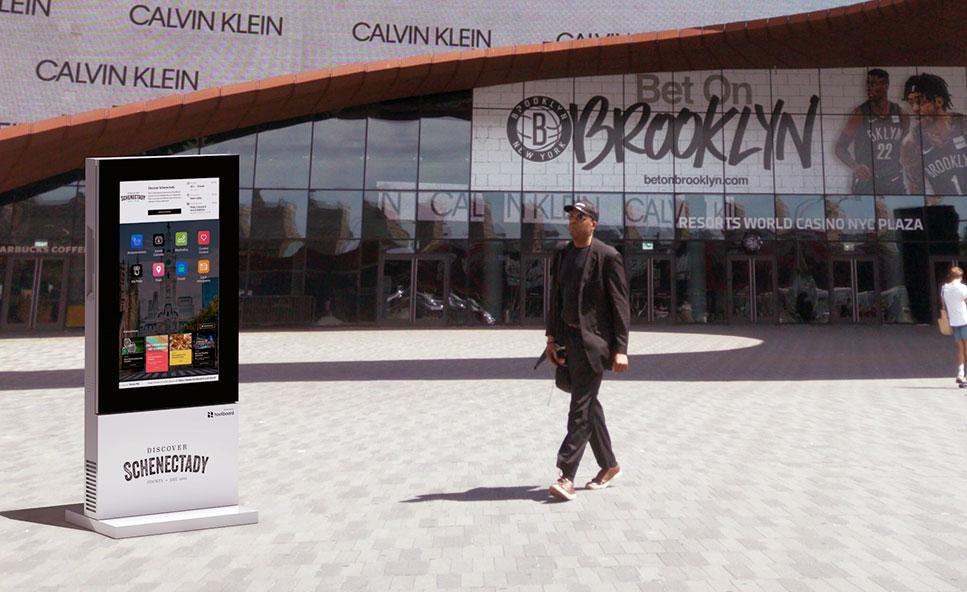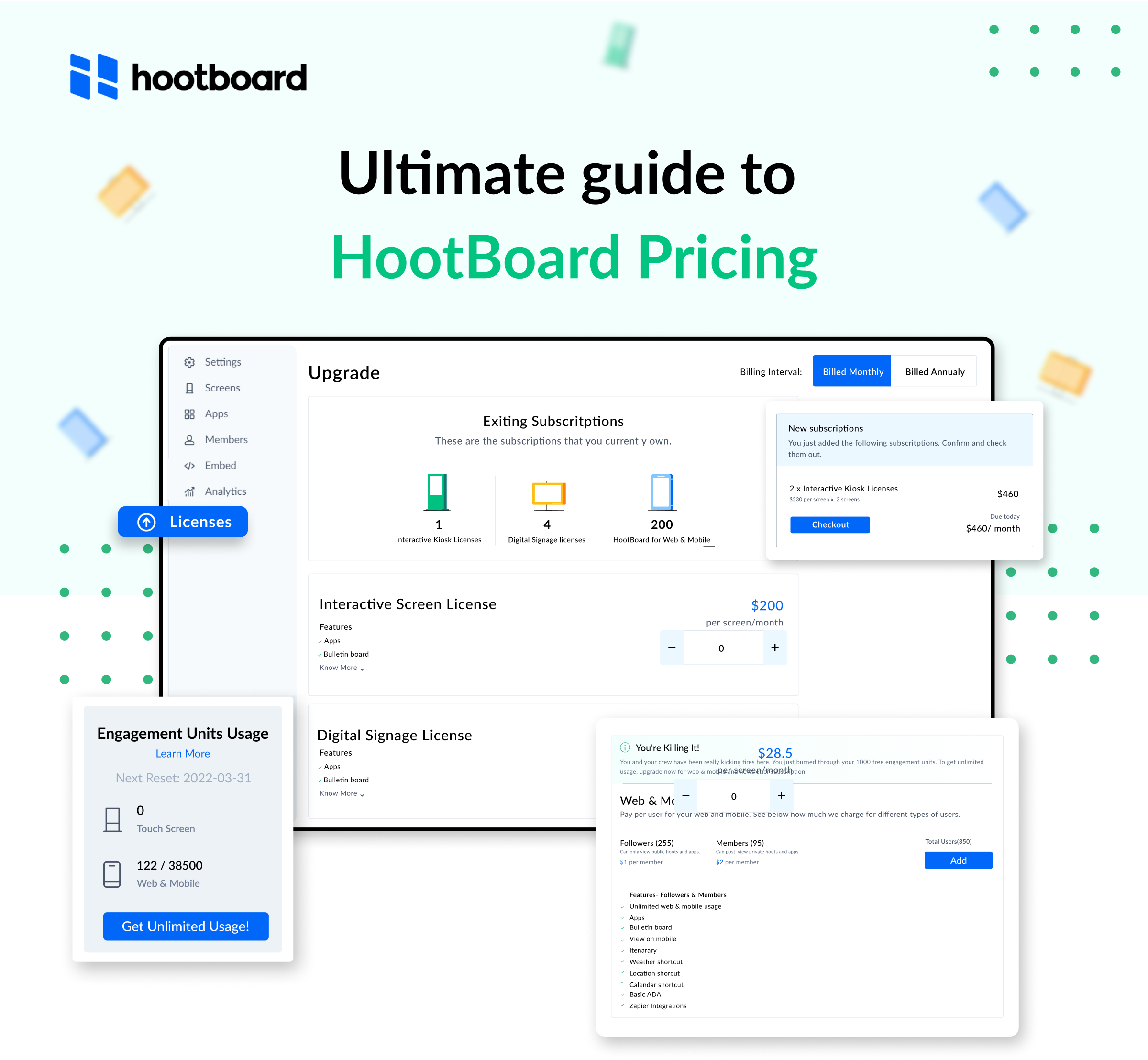Are you looking for a way to spruce up your business with digital signage? Then you’re probably wondering how much you can expect to pay. Want data? Try our digital signage calculator here for hootboard. Investing in digital signage solutions can be a significant but worthwhile expenditure for businesses looking to enhance their content creation and display capabilities. For instance, HootBoard, a leading provider of digital signage software products, offers various options with prices starting from $6,299 USD for models such as the HootBoard Glide and HootBoard Air. Their premium offering, the HootBoard GlideXT, comes at a starting price of $8,199 USD. While the initial digital sign prices might seem high, it’s important to consider the value derived from these commercial displays in terms of engaging and interactive digital signage content. Moreover, some companies also offer free digital signage software trials which can help reduce the overall digital signage cost breakdown. So, when contemplating how much does digital signage set you back, remember to factor in the potential return on your digital signage investment and the enhancement it brings to your display screen.
Let’s take a closer look at the various factors that go into digital sign pricing, so you can make an informed decision. Read on and get ready to learn how much you should expect to pay for your own digital signs. Want specific lined out information? Checkout the ultimate guide to hootboard’s pricing here. 
Factors that Affect the Digital Signs Prices
1). Location
When considering digital signage cost, it’s important to think about where you’ll be placing the signs. Depending on your location, the cost can vary significantly. For instance, if you’re installing in a busy city center or inside a shopping mall, installation costs can be higher due to increased security measures and/or labor costs. On the other hand, installing a digital sign in a rural area may not incur additional costs for installation. Consider your location carefully when trying to determine how much you will need to pay for digital signage. 
2). Size and Quality of Equipment
Another important factor when considering digital sign prices is the size and quality of the equipment you are looking for. If you are wanting a larger display, for example, you could be looking at paying more than if you were to go with a smaller one. The quality of the equipment is also an important factor to consider in pricing. Higher-end displays can cost significantly more than low-end models, so it is important to find a balance between cost and quality that fits your needs. The digital signage network can have different material costs, so make sure your business sign cost fit the sign design needed for your area. 
3). Installation and Maintenance Costs
When budgeting for digital signs, it is important to keep in mind installation and maintenance costs. Professional installation of the digital signs can often be costly, as can the materials needed for mounting if the digital signs will not be installed on a wall or ceiling. Regular maintenance may also come with additional costs, such as service calls or replacements of worn-out parts. While these costs vary by project, they need to be factored into the overall cost of your digital sign project. When you install signs, it’s important to remember how the digital displays and business signs will react to the elements. LED signs look different in direct sunlight, for example. 
Ways to Get The Best Value for Your Money
Research Different Vendors
When researching digital signs, it pays to take the time to research different vendors and manufacturers. Doing this will enable you to compare prices and features so that you can get the best value for your money. It is important to understand what your needs are before beginning your research so that you can narrow down which vendors offer the right product for your purposes. Don’t forget to look into warranties and support agreements in order to ensure that the product you buy is reliable and fits within your budget. When researching different digital sign vendors and manufacturers, there are a few important questions to ask:
- Can the vendor provide any references or customer reviews?
- Are digital signs capable of running various media formats such as videos, images, text, etc.?
- Can the digital signs be controlled remotely?
- How much does installation cost and how long will it take?
- What level of support or maintenance do they provide?
- Is the warranty valid for hardware and software parts?
Given the competitive landscape of most digital signage software, the digital signage price varies greatly depending on the specific features and capabilities offered by each platform. However, one can expect that the investment in such a solution will align with the value it provides in enhancing display communication and audience engagement. Therefore, when considering digital signage pricing, it’s essential to consider both the upfront costs and the potential return on investment. 
Consider Long-Term Use and Return on Investment
When researching digital signs, it is important to consider not only the initial cost of the product, but also its long-term use. The total cost of ownership should be considered, including the return on investment in terms of energy savings and other benefits. Additionally, look into how the product’s features and design make the digital sign more user friendly and reliable over time. This will help you get the best value for your money. 
FAQs
What types of digital signs are available?
Digital signs come in a variety of sizes, shapes, and technologies, depending on the particular application. Common options include LED displays, LCD monitors, and projectors.
Where can I install a digital sign?
Digital signs can be installed both indoors and outdoors – depending on the type of digital sign being used. Popular locations for digital signage installations include lobbies, conference rooms, retail stores, schools, and offices.
How much do digital signs typically cost?
The cost of a digital sign depends on a few factors such as its size, technology used (LED vs LCD), resolution required for the intended display content, etc. Typical costs range from a few hundred dollars to several thousand dollars for higher end models.
What features do digital signs have?
Digital signs support a wide range of interactive features that enable users to control content and add interactivity to their displays. Features such as networking capabilities allow multiple displays to be connected into a single network which can be managed remotely with ease. Additionally they may support plugins such as RSS Feeds or web browsers which allow dynamic content to be displayed without manual intervention every time something needs updating. Some higher end models may also include motion sensors or touchscreens that provide added levels of interactivity with your audience.
Are digital signs energy efficient?
Yes! Because they use modern LED or LCD technology they are far more efficient than traditional illuminated signs or neon lighting used in the past; additionally many models today offer built-in power management settings that limit the power draw throughout any given day or night depending on your needs for display brightness at certain times of day/night or other conditions you set as parameters within the power management system itself.
Is Digital Signage Software Included in the Price?
You should check to make sure the digital signage touchscreen software system includes the cost of the software. Sometimes a digital signage solution separates the digital signage hardware from the software. Be sure to find a company that can answer this so you digital signage budget will help manage your business sign costs.
Digital Signage Prices Can Vary But the Cost is Worth It
Digital signs are an effective way to engage customers and share dynamic content with audiences both indoors and outdoors. They come in a variety of sizes, shapes and technologies, ranging in cost from a few hundred dollars to several thousand. Digital signs have interactive features such as networking capabilities, motion sensors, touchscreens, and built-in power management settings that make them energy efficient. Ultimately they provide an excellent opportunity to captivate people while delivering valuable information.




